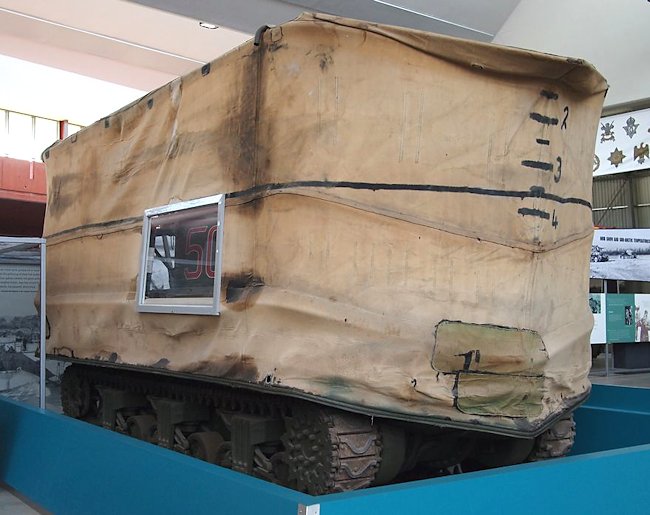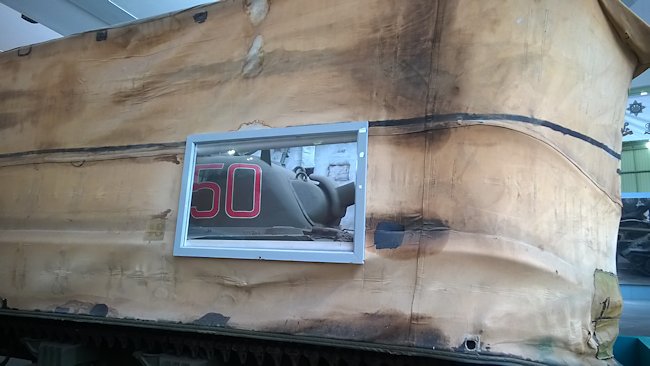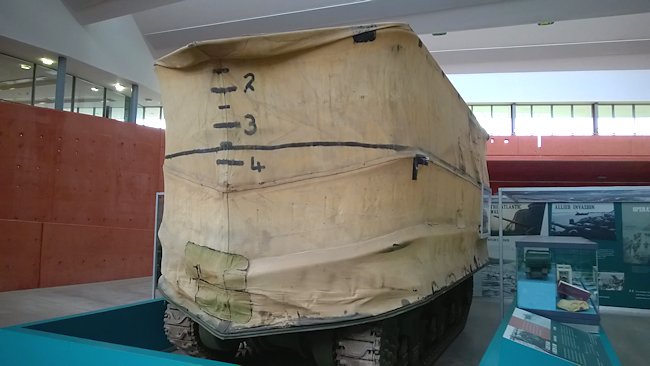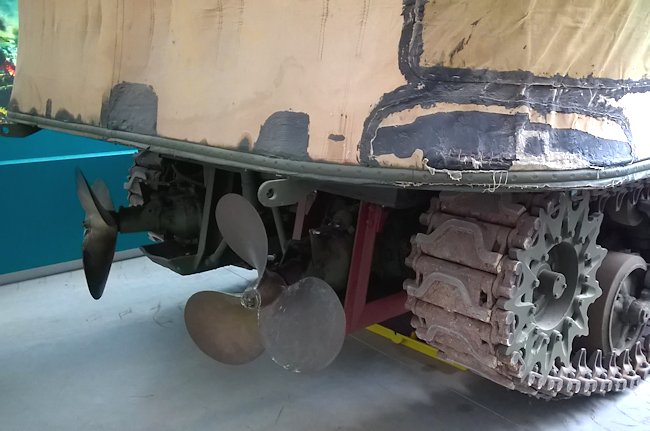The Sherman DD Duplex Drive Tank
Bovington Tank Museum has constructed a very well though-out exhibit built around their preserved Sherman DD Duplex Drive Swimming Tank that was used on D-Day June 6th 1944 on the Beaches of Normandy to provide support for the infantry landing on the beaches.

British Sherman M4A2(75) DD Duplex Drive D-Day Tank
Location
This Sherman DD tank is on show at the Tank Museum, Linsay Road, Bovington, Dorset. The nearest train station is Wool Railway Station. You can walk the 2 miles to the Museum but there are not pavements along the country road and if you are travelling with children it can be dangerous. It takes 45 minutes by foot. There is an irregular bus service from Wool Station that will get you to the museum but they only come once an hour in the morning starting after 9.30.
The last bus back to the station from the Tank Museum is just after 13.45 which is really silly. There is no Sunday bus service. The easiest way to get to the museum from the train station is by taxi. They can be pre booked with Garrison Cars to meet you when your train arrives and pick you up for the return trip from outside the museum. Their phone number is 01929 463395
Specification
The M4A2 Sherman tanks were equipped with a General Motors 6046 engine (2x GM 6-71 General Motors Diesel engines conjoined). It had a maximum road speed of 25 mph (40 km/h) and an operational range of around 120 miles (93 km). The tank needed a crew of five: commander, driver, gunner, loader, co-driver/machine gunner. The tank had a welded hull that ranged in armour thickness from 38mm to 75mm. It was armed with a 75mm M3 L/40 gun and the tank carried 90 rounds. It had one hull mounted 0.30-06 Browning M1919A4 machine gun and another fixed next to the main gun in the turret.

The British Army called the M4A2(75) the Sherman III Tank. It was used as a D-Day Duplex Drive Swimming tank
The Swimming tank
The Sherman DD was an American tank adapted by the British to provide covering fire for the infantry on amphibious operations. The two propellers at the rear powered the tank through water, while the canvas screen kept it afloat. When the tank reached land, the crew collapsed the screen so the gun could fire. Later the screen was cut off and discarded. The idea for the DD came from a Hungarian engineer, Nicholas Straussler.
On D-Day, 6 June 1944, British, Canadian and American regiments successfully used DDS to land on the Normandy beaches, taking the Germany Army by surprise. Having been launched into the sea from landing craft, the tanks swam ashore - in some cases over two miles. However, 27 out of 29 DDS of the 741st US Tank Battalion sunk after being swamped by high waves.

Sherman DD Duplex Drive D-Day Tank
look up to see the outlet pipe at the top of the screen which expelled water via a bilge pump. Inside the screen there was a platform where a crewman stood to steer the floating tank. Also notice the thick black rubber tubes that were inflated to erect the screen.
The watertight screen that enabled this tank to float used the same material as the early beach 'Lilos' (a bit different from the brightly coloured lightweight plastic we use today!). The word 'duplex' means 'having two parts' - the 'Duplex Drive (DD)' had two driving parts, propellers for the sea, and tracks for the land.
When on water, all the crew apart from the driver stayed outside the tank - where there was less risk of drowning if the tank sunk. All the DD crews were trained in submarine escape drills.

Sherman DD Duplex Drive D-Day Tank
Sword Beach
The landings of the British 3rd Infantry Division at the eastern end on Sword beach, between Saint-Aubin-sur-Mer and the River Orne, had heavy guns in support. The battleships HMS Ramillies and Warspite, and the monitor HMS Roberts, were augmented by four cruisers, including the Polish ship Dragon, and thirteen destroyers. The Overlord planners had increased this naval support because of the many German batteries in the sector. Birds in the Orne estuary were driven wild by their gunfire. 'Widgeon and teal fly low over the sea and look like black tracer,' wrote an observer in his diary.
The landing craft were lowered into the heavy sea at 05-30 hours and, after circling, made their way inshore, vainly attempting to maintain formation. One company commander in the 2nd Battalion of the East Yorkshire Regiment read extracts from Shakespeare's Henry V to his men over the tannoy, but most of them were probably too seasick to pay much attention. Many regretted the tot of navy rum with breakfast.
The DD tank crews of the 13th/ 18th Hussars and the Staffordshire Yeomanry felt a different form of nausea when they received the order 'Floater, 5,000!' The launch of the swimming tanks planned for 8,000 yards out had been reduced, but it was still a very long way to go in a sea with waves up to five feet high. Surprisingly, only six out Of forty sank, two of them as a result of being rammed by landing craft out of control. At 06.50 hours, the self-propelled guns of the 3rd Infantry Division also opened fire from their landing craft at a range of 10,000 yards.
Just before landing, an officer with the 41st Royal Marine Commando observed those around him on the landing craft: 'Some were scared shitless, others fiercely proud just to be a part of it. Anticipation with nervous excitement showed everywhere.' The first wave of infantry, the 1st Battalion the South Lancashire Regiment and the 2nd East Yorkshires, arrived to find that the first DD tanks were already ashore and firing at strongpoints.
The South Lancs immediately attacked the German position codenamed 'Cod' opposite the beach. Their commanding officer died ten feet from the top of the beach with the battalion medical officer wounded beside him. A Bren-gun platoon, landing in carriers, charged straight up the beach and the defenders surrendered. The 2nd Battalion of the Middlesex Regiment, which followed, was astonished to be welcomed by a man in a brass fireman's helmet 'like a Napoleonic dragoon'. This was the mayor of Colleville. He was accompanied by a young woman who wasted no time in starting to care for the wounded.
Other young Frenchwomen also showed extraordinary bravery, coming to the beaches to help. Purely by chance, a student nurse who had left her bathing dress in a beach hut the day before had arrived on a bicycle that morning to retrieve it. She ignored the wolf whistles of the amazed squaddies and set to work bandaging wounds. Her work lasted two days and during the course of it she met her future husband, a young English officer.
Juno Beach and the Canadian Landings
Courseulles-sur-Mer had been partitioned into numbered blocks to be dealt with by designated companies. 'Nearly every foot of the town was known before it was ever entered.' said the Canadian commanding officer of the Regina Rifles. He described the performance of the supporting tank crews of the 1st Hussars as 'gallant rather than brilliant', and they learned the hard way.
Even with support from the few remaining DD Shermans, it took until the afternoon to clear the town fully. The Canadians found that having chased the German defenders from some fortified houses, they then returned via tunnels and began shooting at them from behind.
Part of the 8th Canadian Brigade landing at Saint-Aubin-sur-Mer also faced fierce resistance. The North Shore Regiment suffered many losses from an extensive concrete bunker armed with an anti-tank gun, machine guns and 81 mm mortars.
The squadron of DD tanks of the Canadian Fort Garry Horse, which had been delayed, finally arrived. In the confusion, as they charged around the beach, they ran over corpses and several of their own wounded soldiers. A sergeant in 48 Royal Marine Commando who witnessed this also saw a medical orderly in a state of complete shock; unable to face the wounded.
Only the arrival of a Churchill AVRE tank, firing its hefty petard mortars on to the bunker system, brought resistance there to an end at 11.30 hours. Meanwhile another company from the North Shore Regiment, which had entered the town after blowing gaps in the wire with Bangalore torpedoes, continued to fight from house to house, with grenades, rifles and Bren guns. They too faced the danger of Germans re-emerging from tunnels behind them to fight on.
At Bernieres-sur-Mer, the Queen's Own Rifles were reinforced by another squadron of Fort Garry Horse tanks, which, after landing 'dryshod', straight onto the beach rather than into the surf, then lined up on the beach to blast defended houses. A Churchill AVRE tank blew a gap in the sea wall, then engineers prepared ramps for the tanks. Infantry and 'Priest' self-propelled artillery were soon streaming through, followed by the Shermans. The German defenders fled and civilians emerged from their cellars. By 09.00 hours, a bar was open for celebratory drinks.
For those French civians behind Allied lines, rumour ran riot. Some believed that the Sherman DD swimming tanks had crossed the English Channel all on their own, and a few convinced themselves that they had crossed on the bottom of the sea like tracked submarines.
Where can I find other preserved DD Tanks?
- Valentine MkVIII DD - John Pearson Collection England
- Sherman DD M4A2(75) - Bovington Tank Museum, England
- Sherman DD M4A1(75) – Exercise Tiger Memorial, Torcross, England
- Sherman DD M4A1(76) – French Tank Museum, Saumur, France
- Sherman DD M4A1(75) – Small hatch, D-Day Underwater Wrecks Museum, Commes, France
- Sherman DD M4A1(75) – Large hatch, D-Day Underwater Wrecks Museum, Commes, France
- Sherman DD M4A4(75) – Juno Beach, Courseulles-sur-Mer, France
- Sherman DD M4A4(75) – Rixheim, France
- Sherman DD M4A1(75) – Small hatch, Piana delle Orme Museum, Italy
- Sherman DD M4A2(75) - Armoured Corps Museum, Ahmednagar, Maharashtra, India
- Sherman DD M4A2(75) - Jaisalmer War Museum, Jaisalmer, India
- Sherman DD M4A2(75) - Mandoli (near Belgaum), Karnataka, India
- Sherman DD M4A2(76) HVSS - U.S. Army Center for Military History Storage Facility Anniston, AL, USA
ww2 tank books

